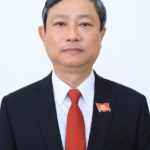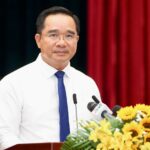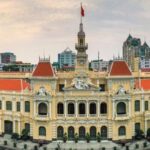Today marks a significant and historic political event for the country, as the nation’s administrative map is rearranged for greater efficiency and stronger development. This is a pivotal moment in our nation’s history, marking the beginning of a new era of prosperity, happiness, and sustainability for Vietnam.
The ceremony in Ho Chi Minh City was graced by the presence of General Secretary To Lam, while Chairman Luong Cuong attended the ceremony in Hanoi. Prime Minister Pham Minh Chinh was present at the ceremony in Hai Phong, and National Assembly Chair Tran Thanh Man joined the event in Can Tho. Standing Member of the Party Secretariat Tran Cam Tu attended the ceremony in Da Nang. Many other Party and State leaders were also present at the ceremonies across various localities.
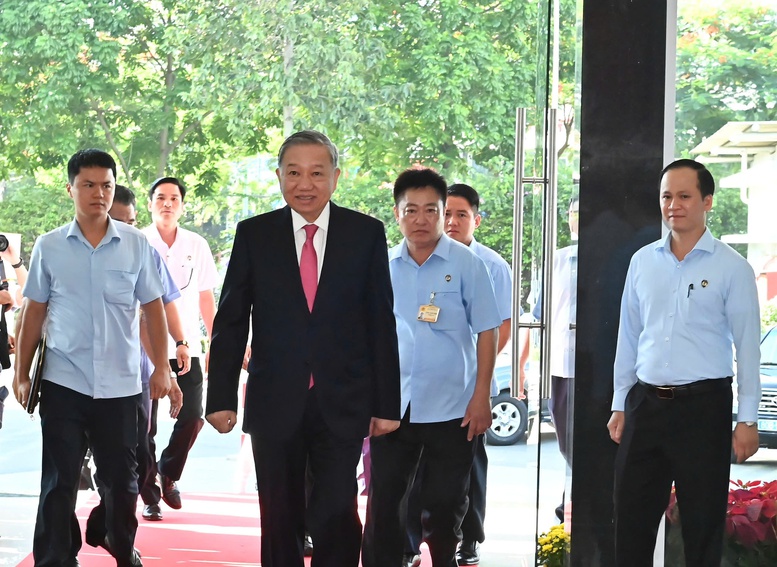
General Secretary To Lam attends the ceremony in Ho Chi Minh City – Image: SGGP
At the Ho Chi Minh City ceremony, the following dignitaries were present:
General Secretary To Lam
; Nguyen Minh Triet, former Politburo member and former President; Nguyen Van Nen, Politburo member and Ho Chi Minh City Party Committee Secretary; Nguyen Thien Nhan, former Politburo member and former Ho Chi Minh City Party Committee Secretary. The ceremony announced the National Assembly’s resolutions and the Government’s decisions on the merger of administrative units at the provincial and communal levels, the termination of administrative units at the district level, and the establishment of Party organizations and the appointment of officials for the People’s Councils, People’s Committees, and Fatherland Front Committees at the provincial and communal levels.
Also in attendance were Central Committee members and former Central Committee members; leaders and former leaders of Ho Chi Minh City, Binh Duong province, and Ba Ria-Vung Tau province; Party Committee secretaries of affiliated levels; and Party Committee secretaries of the newly formed communes and wards.
The new Ho Chi Minh City is formed by merging the entire natural area and population of Ho Chi Minh City, Ba Ria-Vung Tau province, and Binh Duong province. Post-merger, Ho Chi Minh City spans over 6,722 square kilometers
2
and is home to more than 14 million people.
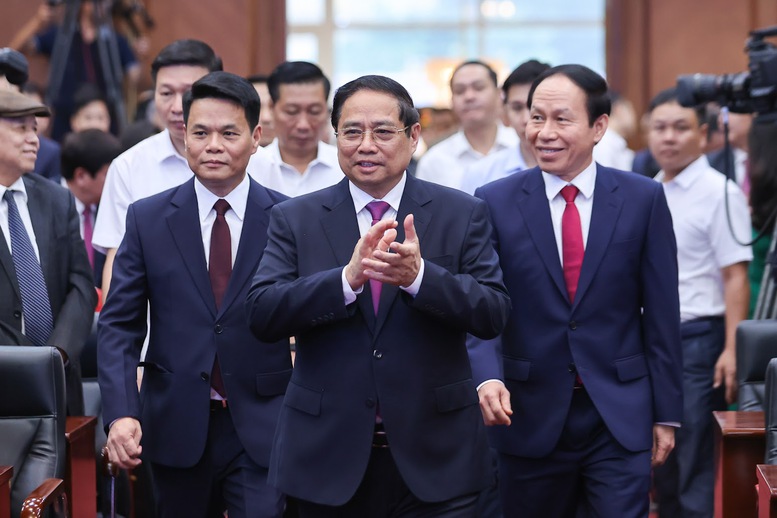
Politburo member and Prime Minister Pham Minh Chinh attends the ceremony in Hai Phong – Image: VGP/Nhat Bac
Politburo member and Prime Minister Pham Minh Chinh
attended the ceremony in Hai Phong, where the resolutions and decisions on administrative mergers and the establishment of Party organizations and the appointment of officials for People’s Councils and People’s Committees were announced.
The new Hai Phong city is established by merging the entire natural area and population of Hai Phong city and Hai Duong province.
The new Hai Phong city covers an area of 3,194.72 square kilometers and has a population of 4,664,124 people. It comprises 114 administrative units at the communal level, including 67 communes, 45 wards, and 2 special wards.
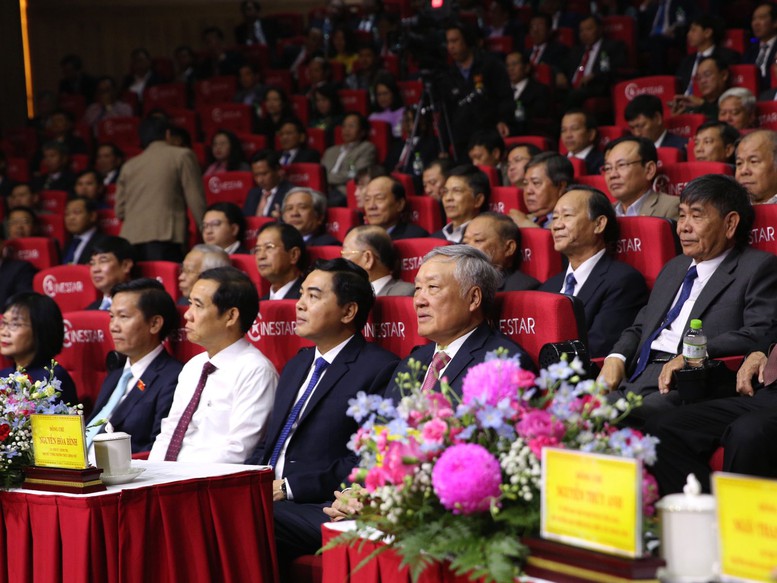
Politburo member and Deputy Prime Minister Nguyen Hoa Binh attends and delivers a speech at the ceremony in Lam Dong – Image: VGP/Nguyen Hoang
Politburo member and Deputy Prime Minister Nguyen Hoa Binh
attended and delivered a speech at the ceremony in Lam Dong.
The new Lam Dong province is formed by merging the entire natural area and population of Dak Nong province, Binh Thuan province, and Lam Dong province. Post-merger, Lam Dong province spans over 24,233.07 square kilometers and has a population of 3,872,999 people. The province now comprises 124 administrative units at the communal level, including 103 communes, 20 wards, and 1 special ward.
With the merger of Dak Nong and Binh Thuan, the new Lam Dong province becomes the largest province in Vietnam in terms of area. This merger not only expands the province’s scale but also restructures the socio-economic development space of the entire region.
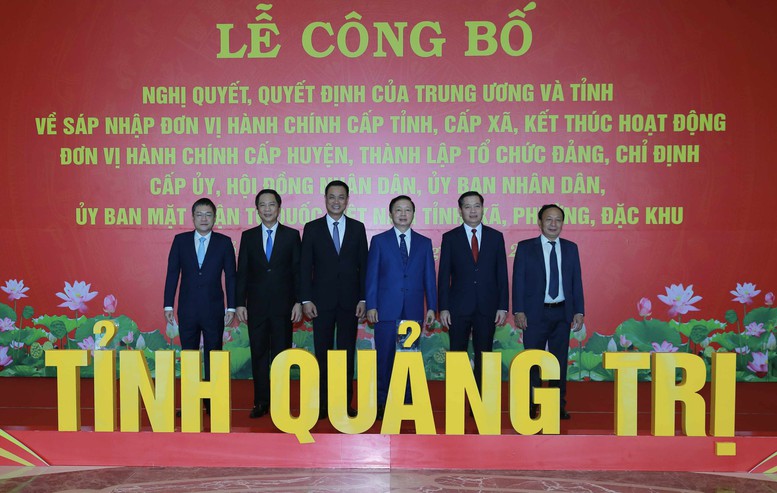
Deputy Prime Minister Tran Hong Ha attends the ceremony in Dong Hoi, Quang Tri – Image: VGP/Minh Khoi
Deputy Prime Minister Tran Hong Ha
attended and delivered a speech at the ceremony in Dong Hoi, Quang Tri, announcing the National Assembly’s resolutions and the Government’s decisions on the merger of administrative units, the establishment of Party organizations, and the appointment of officials for People’s Councils, People’s Committees, and Fatherland Front Committees at the provincial and communal levels in the new Quang Tri province.
Post-merger, Quang Tri province spans over 12,700 square kilometers and has a population of nearly 1.85 million people. With its new scale and potential, Quang Tri is poised to become a comprehensive economic center in North Central Vietnam. Strategically located as a multi-modal transportation hub, Quang Tri serves as a vital link between the sea and the mainland. The province boasts significant potential for tourism, renewable energy, industry, and high-tech agriculture.
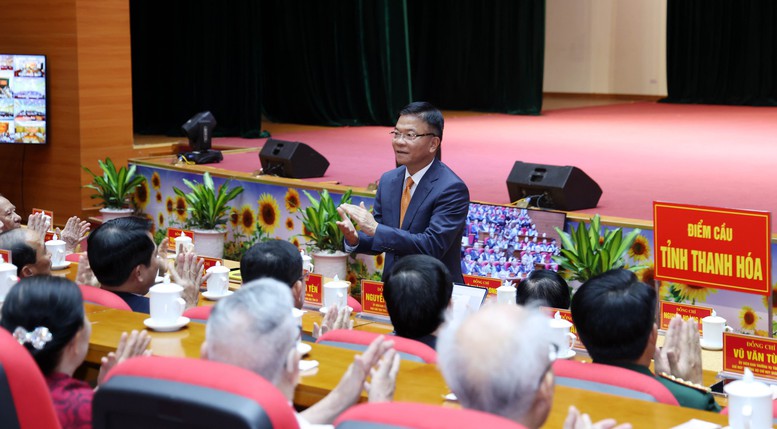
Deputy Prime Minister Le Thanh Long attends the ceremony in Thanh Hoa – Image: VGP/Duc Tuan
Deputy Prime Minister Le Thanh Long
attended the ceremony in Thanh Hoa, where the National Assembly’s resolutions and the Government’s decisions on the reorganization of administrative units and the establishment of Party organizations and the appointment of officials for People’s Councils and People’s Committees were announced.
According to the leaders of Thanh Hoa province, all necessary preparations have been made regarding infrastructure, equipment, information technology systems, platforms, and applications to serve the people, businesses, and the operations of agencies and units.
Localities have also developed plans for human resource allocation based on job positions and have effectively communicated the establishment of the new administrative units to the people. Everything is set for the official launch of the new communes and wards from July 1st, ensuring smooth and efficient operations.
Thanh Hoa province has completed the rearrangement and merger of administrative units at the communal level, reducing the number of units from 529 (including 435 communes, 63 wards, and 31 townships) to 166 (including 147 communes and 19 wards). This merger aims to streamline the administrative apparatus and improve management effectiveness while promoting socio-economic development in the locality.
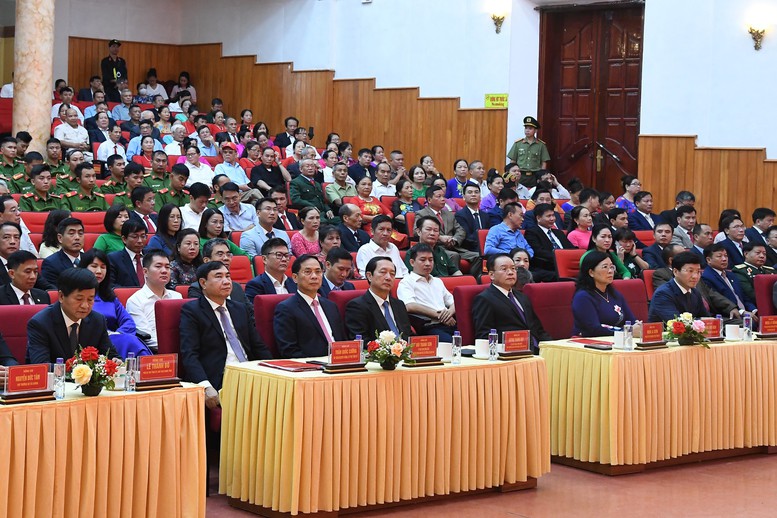
Deputy Prime Minister and Foreign Minister Bui Thanh Son, Deputy Head of the Central Committee’s Commission for Information and Education Huynh Thanh Dat, Secretary of the Dien Bien Provincial Party Committee Tran Quoc Cuong, and representatives of some central ministries and sectors attend the ceremony in Dien Bien – Image: VGP/Hai Minh
At the ceremony in Dien Bien, the following dignitaries were present:
Deputy Prime Minister and Foreign Minister Bui Thanh Son
, Deputy Head of the Central Committee’s Commission for Information and Education Huynh Thanh Dat, Secretary of the Dien Bien Provincial Party Committee Tran Quoc Cuong, and representatives of some central ministries and sectors.
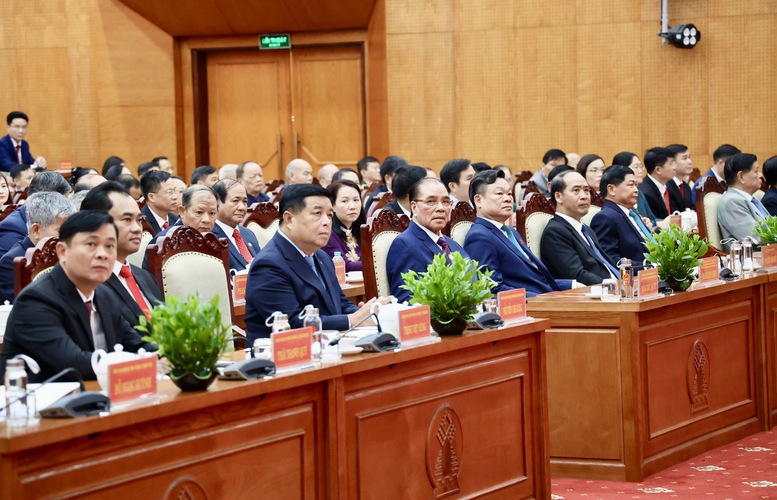
Former Politburo member and former General Secretary Nong Duc Manh; Deputy Prime Minister Nguyen Chi Dung, along with leaders and former leaders of Thai Nguyen and Bac Kan provinces – Image: VGP/Thu Sa
Deputy Prime Minister Nguyen Chi Dung
attended the ceremony in Thai Nguyen, announcing the National Assembly’s resolutions and the Government’s decisions on the merger of administrative units at the provincial and communal levels.
The ceremony in Thai Nguyen was honored by the presence of Nong Duc Manh, former Politburo member and former General Secretary of the Central Committee; representatives of central ministries and sectors; and leaders and former leaders of Thai Nguyen and Bac Kan provinces.
Thai Nguyen province covers an area of 3,534 square kilometers and is home to nearly 1.4 million people. Post-merger, the number of administrative units in Thai Nguyen has been reduced to 55 (from 172 previously). Bac Kan province spans over 4,859 square kilometers and has a population of more than 326,000 people. After the merger, Bac Kan has 37 administrative units at the communal level (down from 108 previously).
Post-merger, the new Thai Nguyen province covers an area of 8,375.21 square kilometers and has a population of approximately 1.8 million people, with 92 administrative units at the communal level. The new Thai Nguyen province has strengths in industry (with metallurgy and mechanics, combined with mineral resources, forming a complete production chain), forestry (with a large forest cover, combined with wood and agricultural product processing), and tourism (with potential to develop eco-tourism and historical sites into attractive tourist routes).
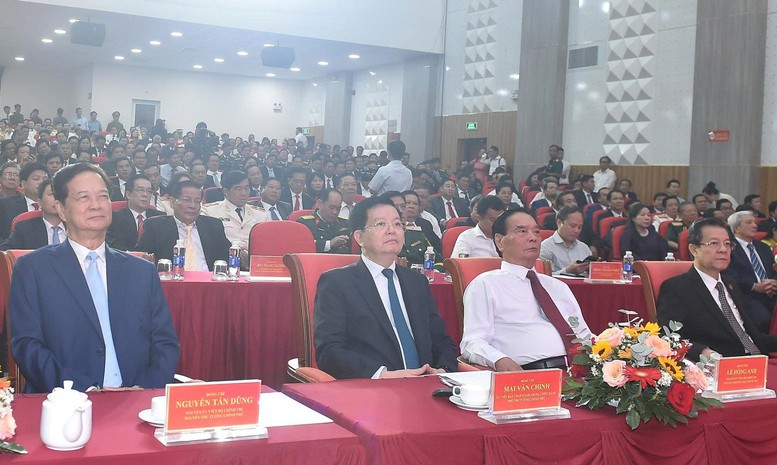
Former Politburo member and former Prime Minister Nguyen Tan Dung; former Politburo member and former Permanent Member of the Party Central Committee’s Secretariat Le Hong Anh; Deputy Prime Minister Mai Van Chinh, along with leaders and former leaders of An Giang and Kien Giang provinces attend the ceremony in Kien Giang – Image: VGP/Giang Thanh
Deputy Prime Minister Mai Van Chinh
attended the ceremony in An Giang, announcing the National Assembly’s resolutions and the Government’s decisions on the merger of administrative units at the provincial and communal levels, the termination of administrative units at the district level, and the establishment of Party organizations and the appointment of officials for the People’s Councils, People’s Committees, and Fatherland Front Committees at the provincial and communal levels in An Giang province.
Also in attendance were former Politburo member and former Prime Minister Nguyen Tan Dung; former Politburo member and former Permanent Member of the Party Central Committee’s Secretariat Le Hong Anh; leaders of central ministries and sectors; and leaders and former leaders of An Giang and Kien Giang provinces.
More updates to follow…
The New Chairman of Ho Chi Minh City’s People’s Committee: Mr. Nguyen Van Duoc
Introducing Mr. Nguyen Van Duoc, the newly appointed Chairman of the Ho Chi Minh City People’s Committee. With a strong political background as a member of the Party Central Committee and Vice-Secretary of the HCMC Party Committee, Mr. Duoc brings a wealth of experience and knowledge to his new role. A skilled communicator and writer, he aims to utilize his talents to serve the people of Ho Chi Minh City effectively and leave a positive, lasting impact.
Unveiling the Newly Appointed Provincial People’s Committee Chairpersons Post-Merger
On the morning of June 30th, provinces and cities held ceremonies to announce the resolutions and decisions of the Central and local authorities regarding administrative unit mergers, the establishment of Party organizations, and the appointment of key positions for the provincial, city, district, and ward levels, including the Party Committees, People’s Councils, People’s Committees, and the Vietnam Fatherland Front Committees.


